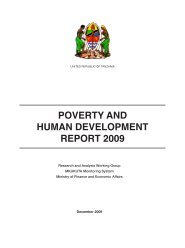Download PDF (4.08 MB) - ReliefWeb
Download PDF (4.08 MB) - ReliefWeb
Download PDF (4.08 MB) - ReliefWeb
Create successful ePaper yourself
Turn your PDF publications into a flip-book with our unique Google optimized e-Paper software.
119<br />
Outputs<br />
Output 1: Livelihoods<br />
and economic opportunities<br />
of returnees<br />
and host community<br />
members, especially<br />
women and youth,<br />
improved<br />
Output 2: Capacity<br />
of returnee and host<br />
communities and<br />
local authorities for<br />
recovery, peace- building,<br />
and risk reduction<br />
strengthened<br />
Output 3: Peacebuilding<br />
and social<br />
cohesion in areas of<br />
return improved<br />
Activities<br />
• Undertake livelihoods and economic recovery assessments<br />
• Facilitate community participatory mobilization processes<br />
• Provide short-cycle skills training and placement<br />
• Rehabilitate community roads, bridges, markets and other key infrastructure<br />
using community contracting, cash for work, and start-up<br />
grants and packages; provide training on infrastructure maintenance<br />
• Provide start-up grants and packages for cash crop production and<br />
small agricultural processing<br />
• Facilitate formation of “business for peace” forums<br />
• Introduce alternative energy technology in areas of return<br />
• Mobilize and train community members to actively participate in<br />
peace-building and recovery; provide life skills training<br />
• Support community organizations to form local networks for recovery<br />
planning; establish community peace committees where possible<br />
• Undertake a capacity needs assessment for support to reintegration<br />
and recovery in target areas; facilitate development of a multistakeholder<br />
capacity development strategy; provide related capacity<br />
development services<br />
• Provide community-based disaster-risk management training; provide<br />
training and emergency equipment to the national disaster management<br />
authority<br />
• Support e-governance initiatives linking IDPs, returnees, and host<br />
communities to state information via mobile phones<br />
• Assess recreational interests and opportunities among youth; map<br />
coaching and mentoring opportunities; identify partners to organize<br />
art/athletic competitions; provide equipment and rehabilitate recreational<br />
facilities<br />
• Facilitate the formation of youth environmental corps for environmental<br />
management initiatives, including “green jobs for peace”<br />
• Undertake participatory analysis of conflict dynamics and local peace<br />
capacities; initiate awareness raising, sensitization, and training of<br />
stakeholders accordingly<br />
• Strengthen or establish agreed platforms for dispute resolution<br />
• Provide seed funding for community-based peace and gender empowerment<br />
initiatives<br />
For additional information on the reintegration of displaced persons and their<br />
livelihoods, please see discussion paper 32. The reintegration of displaced persons and<br />
livelihoods in Annex.<br />
Table 6.3. Example of outputs and activities<br />
fora reintegration initiative for<br />
displaced persons 69<br />
References and suggested further reading:<br />
Reintegration of displaced persons and<br />
their livelihoods<br />
• Castles, Stephen and Nicholas Van Hear, et<br />
al. “Developing DFID’s Policy Approach to<br />
Refugees and Internally Displaced Persons.”<br />
Volume 1: Consultancy Report and Policy<br />
Recommendations. Refugee Studies Centre,<br />
University of Oxford. February 2005.<br />
• IASC. Guidelines for Field Staff for Promoting<br />
Reintegration in Transition Situations. 2003.<br />
• IASC. Mise en Oeuvre de l’Action Concertée Face<br />
aux Situations de Déplacement Interne: Directive<br />
pour les Coordinateurs Humanitaires et/<br />
ou Résidents et les Equipes de Pays des Nations<br />
Unies. 2004.<br />
• UNDG. Guidance Note on Durable Solutions for<br />
Displaced Persons. 2004.<br />
• UNDP. Lessons Learned in Crises and Post-conflict<br />
Situations: The Role of UNDP in Reintegration<br />
and Reconstruction Programmes. 2003.<br />
• UNDP. “Mandate and Strategies Regarding<br />
Internal Displacement—United Nations<br />
Development Programme.” 2003.<br />
• UNDP Evaluation Office. Sharing New Ground<br />
in Post-Conflict Situations: The Role of UNDP in<br />
Support of Reintegration Programmes. 2000.<br />
• UNHCR. Framework for Durable Solutions for<br />
Refugees and Persons of Concern. May 2003.<br />
• World Bank. Forced Displacement – The<br />
Development Challenge. Social Development<br />
Department. December 2009.<br />
69 Adapted from the section of UNDP’s Annual Work<br />
Plan 2011 on interventions for recovery, peace,<br />
and development in Pakistan’s Federally Administrated<br />
Tribal Areas.<br />
Livelihoods & Economic Recovery in Crisis Situations





